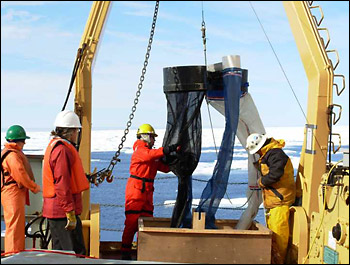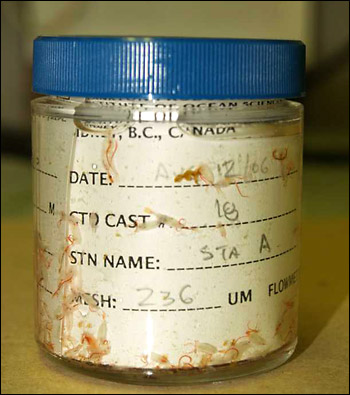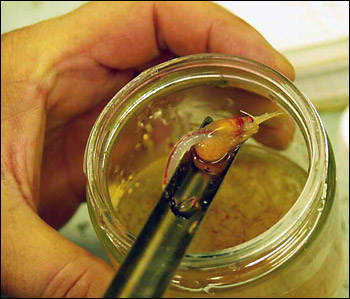Please note: You are viewing
the unstyled version of this website. Either your browser does not support CSS
(cascading style sheets) or it has been disabled. Skip
navigation.
Jennifer Hutchings (IARC)August 14, 2006
So with water this clear, one would think it is devoid of life. Take a closer look however, and one finds life everywhere. I am not just talking about the life on board the ship or the polar bears. Helen Drost (IOS) is studying one part of this story, the life in the ocean. At many points during the cruise, she will be dropping Bongo Nets to trawl for critters. These nets are drawn up from 100 m (330 ft) or 500 m (1640 ft) depth, and filter as they go. There are three sizes of net, which collect creatures larger than 53 micrometers (0.002 in) in containers at the bottom of the net. I find it hard to imagine what a creature looks like that is this small. We are lucky to have a microscope on board, so if you are also curious, watch out for future dispatches on what we see. The samples that come out of the nets contain an interesting array of creatures. Providing much entertainment for the crew of critter preservers, as not one of us is a taxonomist. We are storing the net samples in formaldehyde and ethanol so that they can be identified back home by someone who knows what they are looking at! Today our catch was a shrimp, jellyfish, many many copepods, some arthropods and what appears to me to be sea goo. Helen has identified the shrimp to be of the family Mysid. Last updated: October 7, 2019 | |||||||||||||||||||
Copyright ©2007 Woods Hole Oceanographic Institution, All Rights Reserved, Privacy Policy. | |||||||||||||||||||





